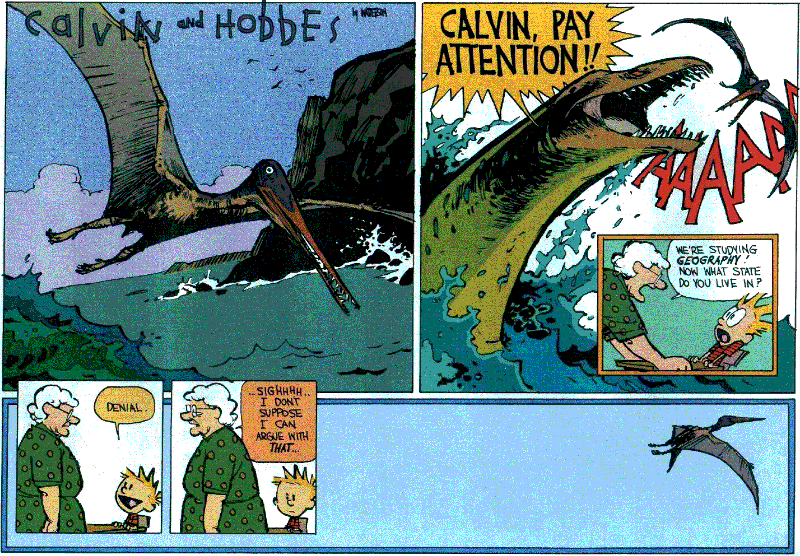 This comic strip is all about the concept of denial. Most psychologists believe denial to be a defense mechanism than can lead to psychological disorders, but Bill Watterson, the author of this strip argues otherwise. Watterson fights against the ill-conceived notions of denial by showing that the imagination, a tool of denial, is something beneficial that we should all use more often. While Calvin looks at denial positively, his teacher represents the negative views associated with it. Like most--if not all--Calvin and Hobbes comic strips, Calvin is the character making a statement in support of Bill Watterson's personal opinions. Clearly, he supports the use of the imagination, even though it can be easily associated to denial. In the case of this comic strip, Calvin imagines himself flying through the sky as a prehistoric bird. This is shown in a positive way because birds and the concept of flight itself is often symbolic of freedom. Calvin, out of complete boredom, denies his own existence in the classroom, thus freeing his mind as the pterodactyl in the comic strip is free from the confines of gravity. Clearly, Calvin's imagination is being shown in a way that supports Watterson's views, thus generating an ethos.
This comic strip is all about the concept of denial. Most psychologists believe denial to be a defense mechanism than can lead to psychological disorders, but Bill Watterson, the author of this strip argues otherwise. Watterson fights against the ill-conceived notions of denial by showing that the imagination, a tool of denial, is something beneficial that we should all use more often. While Calvin looks at denial positively, his teacher represents the negative views associated with it. Like most--if not all--Calvin and Hobbes comic strips, Calvin is the character making a statement in support of Bill Watterson's personal opinions. Clearly, he supports the use of the imagination, even though it can be easily associated to denial. In the case of this comic strip, Calvin imagines himself flying through the sky as a prehistoric bird. This is shown in a positive way because birds and the concept of flight itself is often symbolic of freedom. Calvin, out of complete boredom, denies his own existence in the classroom, thus freeing his mind as the pterodactyl in the comic strip is free from the confines of gravity. Clearly, Calvin's imagination is being shown in a way that supports Watterson's views, thus generating an ethos.  To me, the most evident method of supporting my argument would be to make various comparisons between two aspects of the comic strip. First of all, the strip causes the audience to compare reality and imagination by depicting Calvin's life in small uniformly shaped panels and his imagination in larger, more detailed panels. In a likewise manner, the two frames that show Calvin's teacher yelling and bringing Calvin out of his dream state are both set up in a manner that causes the audience to make another comparison. Finally, the two panels positioned next to each other that display Calvin's reality can be used to compare the positive and negative aspects of the imagination and its role in denial. Of course, after each comparison I must also tie my sub-arguments back to the psychoanalytical context of denial.
To me, the most evident method of supporting my argument would be to make various comparisons between two aspects of the comic strip. First of all, the strip causes the audience to compare reality and imagination by depicting Calvin's life in small uniformly shaped panels and his imagination in larger, more detailed panels. In a likewise manner, the two frames that show Calvin's teacher yelling and bringing Calvin out of his dream state are both set up in a manner that causes the audience to make another comparison. Finally, the two panels positioned next to each other that display Calvin's reality can be used to compare the positive and negative aspects of the imagination and its role in denial. Of course, after each comparison I must also tie my sub-arguments back to the psychoanalytical context of denial.My target audience is anyone who is either against using their imagination or who simply doesn't use it enough. In my opinion, nobody--including myself--ever uses their imagination enough (I suppose you could then say that my audience is everyone). However, my goal is not to force my own opinions onto the audience; I simply hope that a few windows are opened once the audience views Watterson's comic and sees his methods for forming his argument. Psychoanalysis, being the main context of my essay, plays a vital role in supporting my arguments; thus, I need to be certain that my research is accurate considering the fact that my audience may include people who know much about psychology. Also, Watterson's comic does nothing to disprove any theories of psychoanlysis; he is simply expressing his view on the matter. Mentioning this might be helpful in the rare case of some crazy psychologist trying to argue with Bill Watterson or my essay.
No comments:
Post a Comment